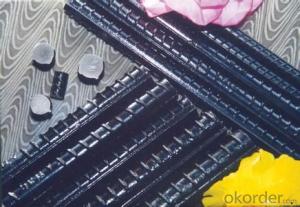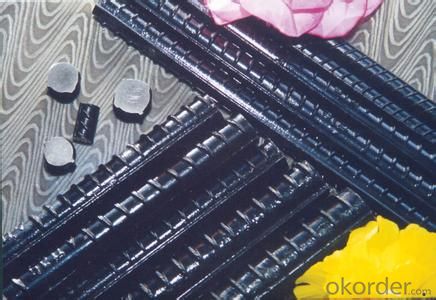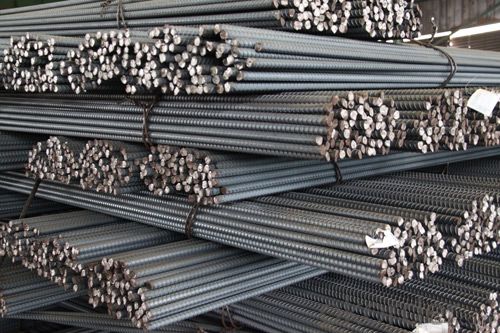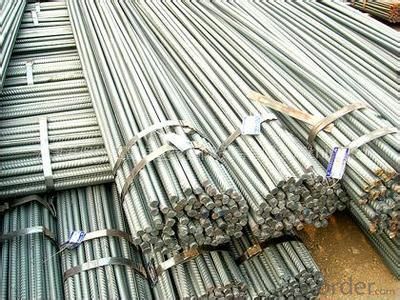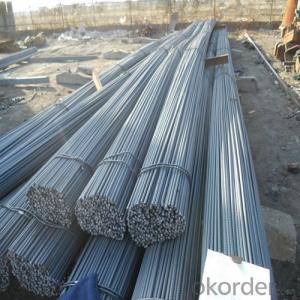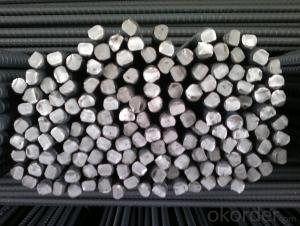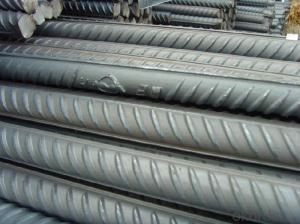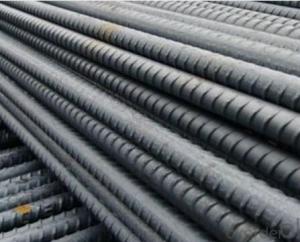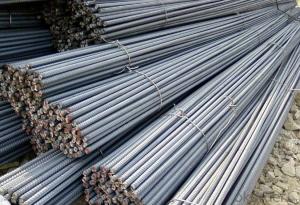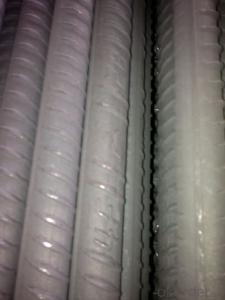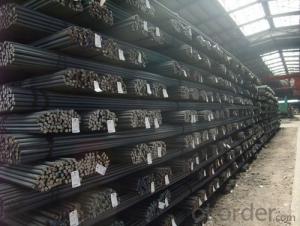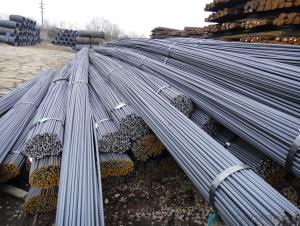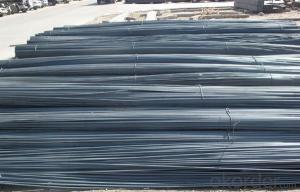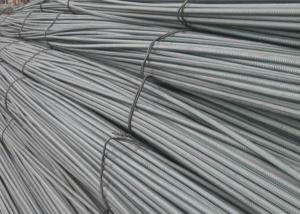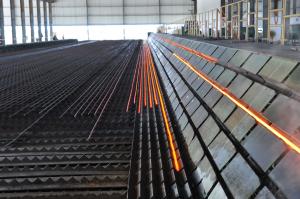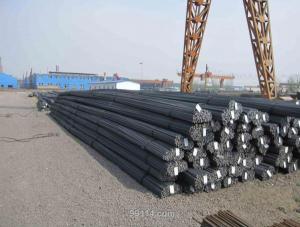Korea standard hot rolled reinforced bar
- Loading Port:
- China Main Port
- Payment Terms:
- TT OR LC
- Min Order Qty:
- -
- Supply Capability:
- -
OKorder Service Pledge
OKorder Financial Service
You Might Also Like
Korea standard steel is also known as the deformed bars, surface bamboo shaped protrusions square or round steel, used for reinforced concrete, than the general square steel and round steel with more firmly. Early domestic steelform is bamboo, then reference the British standard, is now hot rolled ribbed steel bar, JIS and Korean standard screw thread steel or bamboo form.
Hot rolled reinforced bar should have a certain strength, i.e. the yield point and tensile strength, it is the main basis for structure design. At the same time, in order to meet the structural deformation, absorb the earthquake energy andprocessing requirements, hot rolled reinforced bar should also have theplasticity, toughness, welding and bonding properties between steel bar and concrete good.
Classification
Reinforced grade
The strength grade of 24/38 kg, is made of round steel bar killed steel, semi killed steel rimmed steel No. 3 or ordinary carbon steel rolling. It belongs to the low strength steel, has good plasticity, high elongation (delta 5 above 25%),easy bending forming, easy welding etc.. It is used very widely, can be used asthe main force in the reinforcement of reinforced concrete structure, small,member of the stirrups, steel, wood structure of the rod. Wire rod steel can be used as cold drawn low carbon steel wire and double reinforced materials.
II grade reinforced bar
Low alloy steel rolling or semi killed steel reinforced with grade II, with silicon,manganese as solid solution strengthening elements. Level II steel bar intensity level of 34 (32) /52 (50) kg, its high strength, good plasticity, the welding performance is good. The surface of steel rolling longitudinal rib longand uniformly distributed transverse rib, thereby strengthening the bondbetween concrete and steel bars. As with level II steel reinforced concretestructure stress of reinforced, than the use of reinforced grade of steel can be saved 40 ~ 50%. Therefore, widely used in large and medium-sized steel reinforced concrete structure, such as the main reinforcement of bridges,dams, port engineering and building structure. Level II steel after cold drawing,can also be used as prestressing steel building structure.
Grade
III main performance level II steel reinforced with roughly the same strengthlevel for 38/58 kg. Grade was renamed the HRB400 Grade Reinforced bar.Simply put, the same point of the two kinds of steel bar is: all belong to thecommon low alloy hot rolled reinforced bar; belong to the ribbed bar (usually said that the thread bars); can be used for ordinary reinforced concrete structure.
IV grade reinforced bar
IV reinforced the strength level of 55/85 kg, medium carbon low alloy killed steel rolling, which are divided by silicon, manganese as main alloy elements,also adding vanadium or titanium as solid solution and precipitationstrengthening elements, which increases the strength at the same time ensure its plasticity and toughness. Grade rebar surface is rolled with the longitudinal reinforcement and transverse rib, which is the main housing construction of theprestressed reinforced. Reinforcing bar of grade before use by the construction unit for cold processing, cold stress is 750 MPa, in order to improve the yield point, exert the inherent potential of steel products, achieve the purpose of saving steel. The cold drawn steel bar, the yield point is not obvious, so the design in cold stress Statistics (cold drawing design strength)as the basis. But the cold had reinforced after months of natural aging orartificial heating aging, reinforced will appear short yielding stage, its value is slightly higher than that of cold stress, at the same time the steel withhardened tendency, this phenomenon is called "age hardening". Therefore,cold drawn steel while guaranteeing the provisions of cold stress, to control thecold drawing elongation but, lest reinforced brittle. IV grade steel with high carbon content, the general use of flash butt welding - warm - flash welding ortechnology electric heat treatment after welding, to ensure that the weldinghead, including the heat affected zone of hard tissue does not producequenching, prevent the occurrence of brittle fracture. IV grade reinforced bardiameter is 12 millimeter commonly and widely used in prestressed concreteslabs and bundle configuration for components of large prestressedconstruction (such as the roof, crane beam). Hot rolling reinforcing bar of grade as prestressed reinforced when in use, still need to be drawn, welding,its strength is low, the need to further improve.
Finishing rolling rebar
In order to solve the problem of large diameter and high strength prestressed reinforcement and anchorage connection problems, has been developed successfully finishing rolling rebar. It is in the direct rolling steel surface withoutlongitudinal reinforcement and transverse rib reinforced trapezoidal screw buckle shape, available connection sleeve connected with long, with a specialnut as anchorage. This steel has been used in large scale prestressed concrete structure, bridge structure, success.
- Q: How do steel rebars affect the ductility of reinforced concrete?
- Steel rebars can significantly enhance the ductility of reinforced concrete. The presence of rebars improves the tensile strength of concrete, which is otherwise weak in tension. By reinforcing the concrete with rebars, it becomes more resistant to cracking and can better withstand bending or stretching forces without fracturing. This increased ductility allows reinforced concrete structures to better absorb and distribute applied loads, making them more durable and resilient.
- Q: Are steel rebars easy to work with?
- Steel rebars can be both easy and challenging to work with, depending on the specific task and the individual's experience and skill level. In general, steel rebars are known for their strength and durability, making them a popular choice in construction projects. They are relatively easy to handle and manipulate due to their uniform shape and standardized sizes. However, working with steel rebars also requires certain precautions and techniques. Cutting and bending rebars can be physically demanding and may require specialized tools such as rebar cutters and benders. Additionally, the weight of rebars can be a challenge, especially when dealing with longer and thicker pieces. Furthermore, proper safety measures need to be followed when working with steel rebars. Wearing protective gear, such as gloves and goggles, is crucial to prevent injuries. Attention must also be paid to avoid any potential hazards, such as sharp edges and protruding rebars. Overall, while steel rebars can be relatively easy to work with for experienced professionals, they may present challenges for individuals with limited knowledge or tools. It is recommended to seek proper training and guidance when working with steel rebars to ensure safety and achieve precise results.
- Q: What is the role of steel rebars in tunnel construction?
- The role of steel rebars in tunnel construction is to provide reinforcement and strength to the concrete structure, ensuring its stability and durability. The rebars are strategically placed within the tunnel walls and roof to withstand the pressure and tension exerted by the surrounding soil and rock, preventing cracks and collapse. They help distribute the load evenly, enhancing the structural integrity of the tunnel and minimizing the risk of structural failure.
- Q: What are the different types of steel rebars used in high-rise buildings?
- High-rise buildings commonly utilize various types of steel rebars due to their strength and durability. These include: 1. Mild Steel Rebars, also known as black bars, are frequently used in construction. They possess a low carbon content and are easily weldable, making them ideal for reinforcing concrete structures. 2. High Strength Deformed (HSD) Steel Rebars have a higher tensile strength than mild steel rebars. They are created through cold twisting or stretching of mild steel bars, resulting in a deformed pattern on the surface that enhances bonding with concrete. 3. Corrosion-Resistant Steel Rebars are utilized in high-rise buildings located in coastal areas or regions with high humidity. They are coated with epoxy or galvanized to protect against moisture and corrosive elements, preventing rust and deterioration. 4. Carbon Steel Rebars, made of carbon steel, have a higher carbon content compared to mild steel rebars. They offer excellent tensile strength and are often employed in high-rise buildings that require additional reinforcement. 5. Stainless Steel Rebars are highly resistant to corrosion and can endure extreme weather conditions. They are commonly used in high-rise buildings that necessitate long-term durability and protection against rust. 6. TMT (Thermo-Mechanically Treated) Steel Rebars are manufactured by subjecting mild steel bars to a combination of heat treatment and mechanical deformation. This process imparts superior strength and ductility to the rebars, making them suitable for high-rise buildings where seismic resistance is crucial. Each type of steel rebar possesses distinct properties and advantages, enabling engineers and construction professionals to select the most suitable type based on the requirements and specifications of the high-rise building project.
- Q: Can steel rebars be welded or spliced together?
- Yes, steel rebars can be welded or spliced together. Welding is a common method used to join steel rebars together. It involves heating the rebars to a high temperature and then using a welding electrode to melt the steel and create a strong bond between the rebars. Welding is often used in construction projects where a continuous reinforcement is required. Splicing, on the other hand, involves connecting two rebars using mechanical connectors or couplers. These connectors are designed to provide a strong and reliable connection between the rebars. Splicing is often used when rebars need to be extended or when there is a need to join different rebars together. Both welding and splicing methods have their advantages and disadvantages. Welding provides a continuous reinforcement and creates a strong bond between the rebars, but it requires skilled labor and can be time-consuming. Splicing, on the other hand, is quicker and easier to perform, but it may result in a slight reduction in the overall strength of the reinforcement. It is important to note that the use of welding or splicing for steel rebars should comply with the relevant codes and standards, as well as be approved by the structural engineer or the responsible authority.
- Q: Can steel rebars be used in soundproof structures?
- Steel rebars, although they can be utilized in soundproof structures, do not bear the sole responsibility for soundproofing. Their main purpose lies in reinforcing concrete structures like walls or floors. While they can somewhat assist in diminishing sound transmission, accomplishing effective soundproofing necessitates the use of supplementary materials and techniques. To establish a soundproof structure, various factors must be taken into account. One crucial aspect is the mass of the structure. Due to their weight and density, steel rebars augment the mass of the structure, thus aiding in reducing sound transmission. Nevertheless, the efficacy of soundproofing also relies on the overall design, construction techniques, and integration of other sound-absorbing materials. To heighten the soundproofing capabilities of a structure, additional materials can be incorporated, such as acoustic insulation, soundproofing panels, or resilient channels. Acoustic insulation materials like mineral wool or acoustic foam can be installed within the walls or floors to absorb sound waves and prevent their passage through the structure. Soundproofing panels can also be affixed to surfaces to either reflect or absorb sound waves, further diminishing noise transmission. Furthermore, proper construction techniques should be employed to ensure the absence of gaps or air leaks that may permit sound to travel through. The utilization of resilient channels, which isolate the structure from surrounding surfaces, can also aid in reducing sound transmission. In conclusion, while steel rebars can contribute to the soundproofing of a structure through the augmentation of its mass, they alone are inadequate for achieving a fully soundproof environment. Effective soundproofing necessitates a combination of design, construction techniques, and the integration of supplementary sound-absorbing materials to attain the desired level of sound reduction.
- Q: What is the difference between hot-rolled and cold-rolled steel rebars?
- The main difference between hot-rolled and cold-rolled steel rebars lies in the manufacturing process. Hot-rolled steel rebars are formed by heating the steel billet to high temperatures and then passing it through rollers to shape it into the desired rebar size. This process results in a rougher surface and less precise dimensions. On the other hand, cold-rolled steel rebars are manufactured by cooling the steel billet and then passing it through rollers at room temperature. This process produces a smoother surface and more accurate dimensions. Overall, the choice between hot-rolled and cold-rolled steel rebars depends on the specific application and the desired properties of the rebar.
- Q: What are the design considerations for using steel rebars in construction?
- Some important design considerations for using steel rebars in construction include the required strength and load-bearing capacity, corrosion resistance, compatibility with other construction materials, durability, and ease of installation. Steel rebars should be chosen based on their appropriate diameter, grade, and spacing to ensure structural integrity and safety. Additionally, proper detailing and placement of rebars are essential to ensure that they are effectively embedded within concrete and can withstand the anticipated stresses and forces during construction and throughout the lifespan of the structure.
- Q: What are the advantages of using ribbed steel rebars?
- Using ribbed steel rebars in construction projects offers several advantages. To begin with, the ribbed design of these rebars enhances the bonding with concrete. The presence of ribs increases the contact surface area between the rebar and the surrounding concrete, resulting in improved adhesion and prevention of slippage. This ultimately leads to a stronger bond, ensuring the structural integrity of the reinforced concrete. Secondly, ribbed steel rebars provide enhanced resistance against shear forces. The ribs act as anchor points within the concrete, evenly distributing the load and reducing the risk of failure due to shear stress. This makes ribbed rebars particularly suitable for applications that experience high shear forces, such as beams and columns. Additionally, the ribbed pattern of these rebars improves their ductility. Ductility refers to a material's ability to undergo deformation without breaking. The presence of ribs allows the steel rebar to stretch and bend without fracturing, making it more resistant to cracking or failure under stress. This is particularly crucial in earthquake-prone areas, where a structure's ability to absorb and dissipate energy is vital for its survival. Furthermore, ribbed steel rebars demonstrate excellent corrosion resistance. The ribs act as a barrier, effectively preventing moisture and corrosive agents from reaching the steel core. This significantly prolongs the lifespan of the rebar, reducing maintenance costs and ensuring the long-term durability of the reinforced concrete structure. Lastly, ribbed steel rebars are readily available and cost-effective. They come in various sizes and lengths, allowing for easy customization to meet different construction needs. Additionally, due to their popularity and widespread use, ribbed rebars are competitively priced, making them a cost-effective option for reinforcing concrete structures. In conclusion, the use of ribbed steel rebars offers multiple benefits, including enhanced bonding with concrete, improved resistance to shear forces, greater ductility, excellent corrosion resistance, and cost-effectiveness. These advantages make ribbed rebars an ideal choice for reinforcing concrete structures, guaranteeing strength, durability, and longevity in construction projects.
- Q: Does the grade three thread steel with "E" have the same information price as the ordinary three grade thread steel? Is there a big difference?
- Hello, with E thread steel is seismic rebar, without E is the common thread steel, general seismic thread with E was higher than that of ordinary steel prices, the price difference between 50 and 100 yuan, according to the specific market situation.
Send your message to us
Korea standard hot rolled reinforced bar
- Loading Port:
- China Main Port
- Payment Terms:
- TT OR LC
- Min Order Qty:
- -
- Supply Capability:
- -
OKorder Service Pledge
OKorder Financial Service
Similar products
Hot products
Hot Searches
Related keywords
